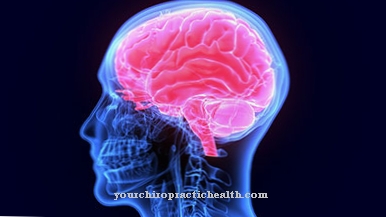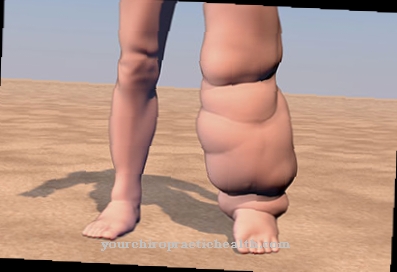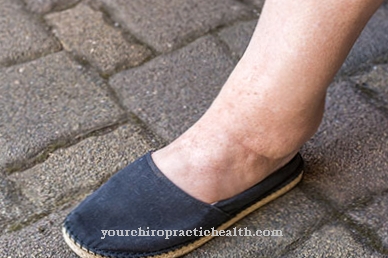The Joubert syndrome is characterized by a congenital malformation of the brain stem as well as an agenesis (inhibition malformation, lack of attachment, for example cerebral bars, appendix). Hypoplasia (underdevelopment) of the cerebellar worm can also exist. Patients who suffer from this autosomal recessive genetic defect show, among other things, abnormal breathing behavior and ataxia.
What is Joubert Syndrome?

© Sashkin - stock.adobe.com
People with Joubert syndrome suffer from developmental disorders of the central nervous system and the resulting functional disorders. Medical research is controversial as to whether this genetic disorder should be classified as a disease in its own right.
The affected patients have a variety of different symptoms. Because of this, a final diagnosis is difficult. The JB is characterized by extensive gene locus heterogeneity. So far, multiple gene mutations have been identified. A mutation analysis is very extensive.
causes
Joubert syndrome belongs to the group of primary ciliophatias. With this genetic disorder of the primary cilia or the basal body, different types of developmental disorders can occur. As special cell processes, cilia perform various tasks. They act as chemo, mechano and osmosis sensors and are involved in many signaling pathways. Furthermore, they ensure normal organ development.
They maintain the tissue homeostasis of the basic developmental processes. A large number of the proteins involved form a complex network through interaction. If other organs are affected in addition to the main symptoms, then the JSRD (Joubert Syndrome Related Disorder) is present. This secondary disease is characterized by further organ manifestations involving the kidneys, liver and eyes.
It is a genetically heterogeneous syndrome. Doctors have found malformations in the NPHP6 / CEP290 gene (coding for nephrocystine-6) or in the NPHP8 / RPGRIP1L gene (coding for nephrocystine-8). Other gene mutations are MKS3, ARL13B, AHI1, CC2DA2, TMEM216 and INPP5E. Only a few patients have mutations in NPHP4 and NPHP1.
Symptoms, ailments & signs
The pathognomonic feature is the "molar tooth sign" (MTS), which can be determined using "axial T1-weighted brain magnetic resonance imaging". This feature is characterized by agenesis or hypoplasia of the cerebellar worm or cerebellar worm. Furthermore, the posterior interpendicular fossa (pit between the cerebral legs) is strongly drawn in and the cerebellar stalks have a prominent superior shape due to a malformation of the midbrain.
In addition to MTS, patients often suffer from respiratory disorders, ataxia, muscular hypotension and psychomotor retardation. 8 to 19 percent of those affected show postaxial polydactyly (multiple fingers) and six percent an occipital (meningo) encephalocele, in which the back of the brain is bulging.
This deformity was first recorded in 1969. The prevalence is approximately 1: 100,000, a ratio that shows how infrequently the disease appears. Only one hundred cases have been documented since the first medical survey. Since this genetic defect occurs in different forms and variants, doctors assume multiple changes in genetics.
An exact anomaly has not yet been conclusively verified. However, a mutation of the X chromosome is considered certain. This disorder is passed on on the basis of autosomal recessive inheritance. A missing vermis cerebelli (cerebellum, cerebellar worm), damage to the retina and a noticeable iris are involved.
Frequently occurring symptoms and complaints during the neonatal period are nystagmus and an irregular breathing pattern as episodic tachypnea and apnea. Young children can develop hypotonia. With advancing age, imbalance and an uneven gait develop (ataxia). These main symptoms are also known as motor milestones.
The patients have different levels of cognitive abilities and can be severely impaired, but they can also show a normal level of intelligence. Oculo-motor apraxia (movement disorder) is also possible.
Characteristic of this genetic defect are craniofacial abnormalities such as a large head, rounded and high eyebrows, a prominent (protruding) forehead, a deformed mouth, a rhythmically moving and protruding tongue, and deep-set ears. Occasional symptoms are nephrophthisis, retinal dystrophy, and polydactyly.
Diagnosis & course of disease
A diagnosis is made on the basis of the previously cited characteristic milestones of ataxia, hypotension, oculomotor apraxia, open vermis cerebelli after the 18th week of pregnancy and developmental delay. In addition, a characteristic neuroradiological finding is made in the MRI, the MTS (Molar tooth sign).
This feature, known as the molar sign, is due to malformations of the lozenge and midbrain as well as the hypoplasia of the small brain worm. Differential diagnoses are made on the basis of diseases closely related to JS such as JSRD (Joubert syndrome related disorder), Dandy-Walker malformation (malformed cerebellar worm without MTS), types 1 and 2 of oculomotor apraxia, ponto-cerebral hypoplasia and atrophy, 3-c Syndrome, orofacio-digital syndromes II and III as well as the Meckel-Gruber syndrome.
Stage I includes the “next-generation sequencing-based panel analysis” of the genes JBTS5 (53 coding exons), JBTS3 (26 coding exons), JBTS6 (28 coding exons) and JBTS9 (36 coding exons). The JBTS4 gene is tested for homozygous deletion by multiplex PCR. In stage II, the other JB genes are analyzed by PCR (a process that duplicates gene sequences in the DNA chain depending on the enzyme) and subsequent Sanger sequencing, depending on phenotypic features, corresponding to decreasing mutation frequencies.
In order to rule out chromosomal imbalances, the differential diagnostic SNP array analysis is carried out. If there is a consanguinity or if several sick persons are known within the family, the doctors carry out the homozygosity screening by means of coupling analysis in the microsatellite marker flanking the gene and subsequent gene analysis using Sanger sequencing. Two to ten milliliters of EDTA blood are taken from children as diagnostic material; from adults the amount is five to ten milliliters.
DNA or tissue material is also suitable. Stage I: Genomic DNA material is examined for the existence of duplications or deletions by means of a quantitative analysis of the NPHP1 gene using MLPA. Very small amounts of DNA in the genome are examined for deletions and duplications of individual exons (gene segments). Stage II: The coded exons of the genes identified so far are evaluated using next-generation frequencies. The splice sites are enriched by probe hybridization.
Complications
Joubert syndrome causes most patients to suffer from various ailments. This usually leads to short stature, breathing disorders and, furthermore, to retardation. The mental development of the child can also be restricted. The breathing difficulties can also lead to shortness of breath, which must definitely be treated.
It is not uncommon for the person's parents to suffer from severe depression or other psychological disorders. The patients also show disorders of balance and often suffer from restricted mobility. It is not uncommon for discomfort to the eyes and ears, leading to hearing loss or visual problems. The quality of life of the patient is significantly reduced by Joubert syndrome.
With the help of various therapies, Joubert syndrome can be restricted and treated. Unfortunately, a causal treatment cannot be carried out. In emergencies, emergency ventilation can also be carried out if there is a shortage of breath. There are no particular complications in the treatment itself. In general, it cannot be predicted whether the patient's life expectancy will be reduced by Joubert syndrome.
When should you go to the doctor?
An expectant mother should take part in all available check-ups during pregnancy. In the examinations, the state of health of the pregnant woman as well as that of the unborn child is examined. Since Joubert syndrome can be diagnosed as early as the 18th week of pregnancy, it is advisable to make use of the preventive medical check-ups recommended by the health insurance companies. In addition, if there is a genetic defect in the history of the parental ancestors, genetic counseling and examination are generally advisable.
In the unlikely event that no irregularity was found in the womb, automatic check-ups by obstetricians and paediatricians take place immediately after delivery. Breathing disorders can be detected during these examinations. If the child’s parents notice any unusual discrepancies that have previously gone undetected, the observations should be discussed with a doctor. If there are any physical peculiarities, short stature or deformities, a doctor should be consulted.
If, in direct comparison with children of the same age, language problems or mental underdevelopment are noticed, a doctor should be consulted. Investigations are necessary to clarify the cause. The sooner a diagnosis is made, the earlier targeted therapies can be initiated to support the child. Consultation with a doctor should therefore be made at the first sign of an abnormality.
Treatment & Therapy
The parents are entitled to genetic counseling. The treatment options are as diverse as the causes of this disease are diverse. In the case of motor development disorders and hypotension, educational support programs, language, occupational and occupational therapy, which can have a beneficial effect on the course of the disease, come into play.
Those affected with abnormal breathing patterns can also be given oxygen substitution or ventilation. Patients with mild symptoms have a positive prognosis. Severely affected patients must be cared for by an expert reference center.
Outlook & forecast
The prognosis for Joubert syndrome is poor. This syndrome is a genetic disorder. With the current medical, scientific and legal requirements, this cannot be cured. Researchers and doctors are legally not allowed to change the genetic conditions of a person through interventions. For this reason, the treatment is directed towards the use of therapies that are intended to improve the existing quality of life. Without the use of medical care, the patient's reduced well-being is further reduced.
The earlier the syndrome can be diagnosed and treated, the better the results will be. In emergency situations, emergency ventilation of the person concerned is indicated, otherwise the patient may die prematurely. Although numerous therapies are put together and applied in an individual treatment plan, the existing disease can lead to secondary disorders. These worsen the overall prognosis.
Existing functional disorders or other restrictions on movement can lead to mental illnesses. Temporary or persistent depression, mood swings or changes in personality are documented in many patients. This represents an additional burden for the person concerned and the environment. The everyday life of a patient with Joubert syndrome can often only be managed with sufficient help and support from relatives. Balance disorders and ataxia become more severe with age.
prevention
Since an exact genetic causation has not yet been conclusively determined, there are no preventive measures in the clinical sense. The only way to counteract malformations in the human organism is to lead a healthy lifestyle.
Aftercare
In most cases, the patient with Joubert syndrome has no direct or special follow-up options available, so that the person affected is primarily dependent on a quick and, above all, early diagnosis of the disease. The earlier the disease is recognized, the better the further course will usually be. It is therefore advisable to contact a doctor at the first symptoms and signs.
With this disease, the person affected is usually dependent on intensive care and therapy that can alleviate the symptoms. The help and support of parents and close relatives is also very much in demand in order to enable the person affected to lead a normal life as possible. Often the exercises from physiotherapy or physiotherapy can also be performed in your own home, which can alleviate the symptoms.
The symptoms cannot always be completely alleviated. Contact with other sufferers of Joubert syndrome can also be very useful, as it is not uncommon for information to be exchanged. As a rule, the life expectancy of the person affected is not reduced by this disease.
You can do that yourself
Joubert syndrome is incurable and everyday help is also difficult. The symptoms of the congenital disease are in most cases unavoidable. Still, it is possible that some of them will be alleviated.
Since breathing is particularly disturbed in those affected, this is a starting point. An optimized room climate can be helpful. Dry heating air can exacerbate breathing problems. Air that is too cold has the same effect. Ideally, the room temperature is around 20 ° C and the humidity around 50 percent. Indoor plants in particular can contribute to an optimal indoor climate. Alternatively, damp towels can also be placed in the room to keep the humidity at the desired level. The indoor climate can be tracked using a hygrometer. Another starting point that also targets breathing is breathing exercises. Regular use improves the perception of the otherwise automatic process. In this way, you can prevent breathing too quickly and breathing pauses.
It also makes sense if those affected do not sleep alone in a room. Relatives may notice pauses in breathing during sleep and wake the patient or stimulate them to breathe. But that's just a precaution.

.jpg)
.jpg)

.jpg)



















.jpg)



